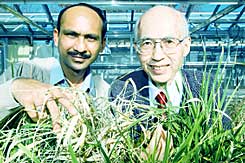Agriculture / The new development may correct the negative image of genetically modified crops
Tamara Traubman

Researchers Wu (right) next to the engineered rice, and Greg next to natural rice
The diet of more than half of the world's population relies mainly on rice, but harsh agricultural conditions and drought in poor countries make it difficult to grow sufficient amounts of rice to satisfy the hunger of billions of people. Some scientists are trying to improve the yield of rice crops through genetic developments: at the beginning of the year, two multinational research teams published a decoded copy of the genome of the two most common varieties of rice, and in Europe scientists are working on developing rice with increased amounts of vitamin A, the lack of which is the main cause of blindness Children in India.
One day another study will be published, in which scientists from Korea and the USA succeeded in developing a rice variety with an improved ability to grow in drought and brackish water conditions. Enter creator
through genetic engineering and incorporated genes from the E. coli bacterium. to make the
To make the strain more resistant, the scientists combined two genes taken from the bacteria and inserted them
For basmati rice.
These genes are responsible for the production of a sugar derivative called "trehalose", which is found
in small amounts in many types of plants, insects, fungi and bacteria, and
In relatively large quantities in plants that are able to survive extended periods in the condition
drought, then grow again when they get water again.
According to Prof. Ajay Garg, head of the research team, adding the genes to rice was
A similar effect on the plant. "We can withhold water from the plant for 10 days and then
It will look dead," said Gragg, "but when water is added to it, the plant recovers." However, Gragg added, normal rice plants would not be able to recover under similar circumstances.
The team of researchers also tested the resistance of the new rice variety to brackish water, and found that there was an improvement in this area as well. "After prolonged exposure to brackish water, almost all the genetically modified plants survived. In contrast, all the non-transgenic plants died or nearly died because of the damage," the researchers wrote in the research report, which will be published today in the online edition of the scientific journal "PNAS
According to Prof. Ray Wu, another partner in the study, this means that farmers will be able to grow rice in fields where it was not possible to do so before, because of salty or arid soil or because of cold weather.
Along with the genes, DNA segments were inserted into the rice that control the timing and location where the genes will operate in the plant. According to Wu, the genes only come into action when the plant is exposed to brackish water conditions. They work in the stem of the plant and its leaves, but not in the edible seeds.
The new rice is not yet ready for marketing and has only been tested in laboratory experiments. The researchers estimate that it will take a few more years to complete its development. According to them, safety trials must also be conducted to make sure that the new variety is safe to use.
In Europe, and to a certain extent in the USA and Israel, there is strong opposition to genetically modified crops. The opposition comes from many sources and stems from various reasons. Religious-conservative elements in the US, for example, claim that genetic engineering is a violation of God's creation; Consumer groups, organizations for the protection of the environment and critics of globalization claim that the genetically engineered crops may harm the environment and human health, and that the giant corporations that produce the plants use them to exercise a new type of monopoly over agriculture and food consumption.
The genetically engineered crops currently on the market were designed to increase crop yields,
and are intended to increase the wealth of the biotechnology companies and the profits of farmers. however,
As mentioned, the new development may turn out to be relevant mainly to the poor. Many scientists
It is hoped that growths of this type will help improve the bad image that has come out so far
for the transgenic plants.
The knowledge website was until 2002 part of the IOL portal of the Haaretz group

One response
The article was published in 2002 and since then about 9 years have passed.
Is it possible that this type of rice was released to the general market? Does it still exist today?
Is it expensive to grow? Is it water resistant?
Is it possible to grow it in our country?
I would be very happy to receive answers.